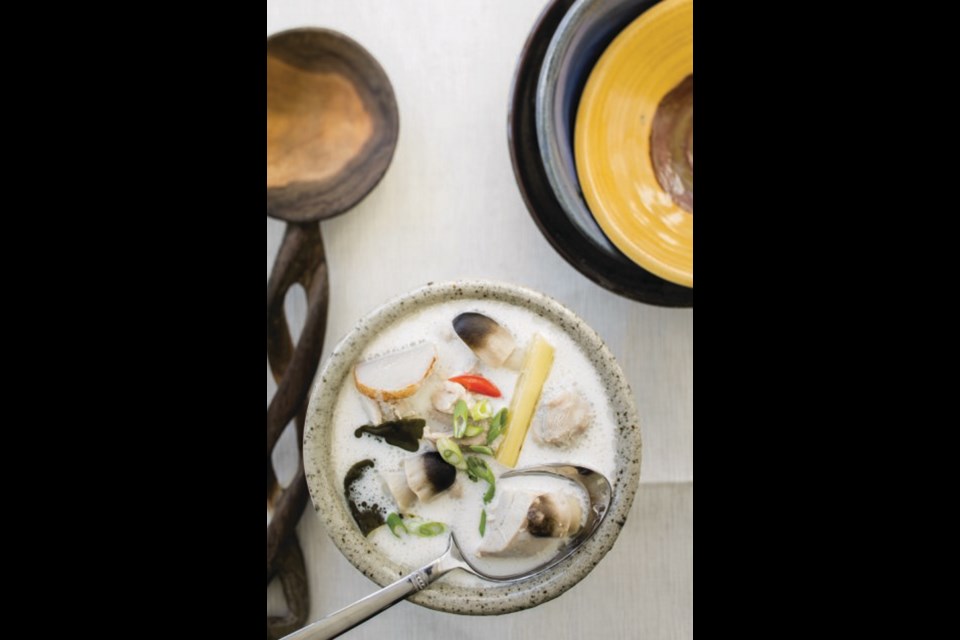 Dear Eric: Can you tell me the difference between galangal and ginger?
Dear Eric: Can you tell me the difference between galangal and ginger?
Jen
This question was posed not long after I published a recipe for Thai-style curry. In it, I gave the option to use either fresh galangal or ginger, but I didn’t have room to mention the difference between the two.
Today I do.
Ginger is the fragrant, knobby rhizome — underground stem — of a perennial herb that’s part of the Zingiberaceae family. It’s officially known as Zingiber officinale. When the plant matures and its leaves die, the tan-skinned rhizome, the ginger, is harvested.
In Charmaine Solomon’s book Encyclopedia of Asian Food, she writes that while in Western cuisines, dried or candied ginger may be used in things such as gingerbread, ginger beer and chocolate ginger, in Asian dishes ginger is almost always used fresh.
In fact, the use of fresh ginger is so prevalent in Asian cuisines, that Solomon describes it as a base ingredient, with soups, noodles, stir-fries and steamed dishes being just a few of the foods it’s added to.
Solomon says the main exception to the above is Thai cuisine, where she says galangal is preferred.
Galangal, pronounced guh-LANG-guhl, is also a rhizome and a fellow member of the zingiberaceae family. It is similar in appearance to ginger and Solomon says it’s sometimes called Thai ginger.
But when it comes to taste and aroma, the two are differen. In the recently published cookbook Hot Thai Kitchen, author Pailin Chongchitnant is adamant about that.
“[Galangal] may look like the sister of ginger, and you may be tempted to use the two interchangeably, but trust me, the flavours are as different as yin and yang,” Chongchitnant writes.
She says galangal has a cooling, woodsy fragrance that’s reminiscent of a lush pine forest after a rain. While many know the spicy, slightly sweet, peppery taste of fresh ginger, galangal tends to taste more like pepper than ginger. It also has a whiter flesh and is much denser than ginger, whose pale greenish/yellow to ivory flesh can almost be juicy.
Chongchitnant is right: galangal and ginger are different. So why would some recipes calling for fresh galangal, such as my Thai curry recipe, give you the option to use ginger instead?
The simple answer is that finding fresh galangal in Victoria over the years has been a challenge, but that has changed. Before writing this column, I was able to find it at Fisgard Market in Chinatown and at some Fairway Market locations.
Some places also sell sliced and dried galangal that you soak and reconstitute in warm water before using. You can use it in place of fresh galangal, but I find it never has the same robust flavour.
When fresh galangal is used to infuse a dish with flavour, such as soup, it’s usually sliced, skin on. For things such as Thai curry pastes, where it will be blended with other ingredients, it’s peeled and then cut, as needed.
When purchasing fresh galangal, choose firm, almost bright-looking pieces free of any soft, sunken spots.
Today’s recipe is from Chongchitnant’s new book and you can tell by its name, Coconut Galangal Chicken Soup, it requires galangal, not its sister, ginger.
Coconut Galangal Chicken Soup
This recipe, called Tom Ka Gai in Thai, is from Pailin Chongchitnant’s fabulous new book Hot Thai Kitchen (Appetite by Random House, $29.95). Chongchitnant says there’s something so comforting and satisfying about this soup, which is smooth, clean and subtle, a wonderfully quiet break from other, “louder” Thai dishes.
Cooking time: 30 minutes
Makes: Four servings
2 cups chicken stock, unsalted
1 lb. boneless, skinless chicken thighs, cut into bite-sized pieces
1 tsp salt
1 1⁄2 cups coconut milk
1 stalk lemongrass, bottom half only, smashed and cut into 2-inch pieces
10 slices galangal, sliced into thin rounds
5 kaffir lime leaves, torn into chunks
2 to 3 Thai chilies,
crushed just until broken
1 1⁄2 to 2 Tbsp fish sauce
1 tsp palm sugar, finely chopped, packed
5 1⁄2 oz. straw or oyster mushrooms,
bite-sized pieces
2 to 2 1⁄2 Tbsp lime juice
• chopped cilantro and/or green onions to taste, for garnish
• steamed jasmine rice, to taste,
for serving (optional)
In a medium pot, add the chicken stock, chicken thighs and salt; simmer gently for 15 minutes, loosely covered, until the chicken is fork tender.
Add the coconut milk, lemongrass, galangal, kaffir lime leaves, Thai chilies, 11⁄2 Tbsp of the fish sauce and palm sugar. Simmer for three to five minutes to infuse.
Add the mushrooms and cook for another one to two minutes to soften. Remove from the heat and stir in 2 Tbsp of the lime juice. Taste and adjust the seasoning with more fish sauce and/or lime juice if needed.
Garnish the soup with chopped cilantro and/or green onions. If desired, you can pour the soup over rice, add rice to the soup bowl, or enjoy the soup on its own. This soup is usually mildly spiced, but you can break up the chilies to release more heat.
Note: Chongchitnant says the lemongrass, galangal and kaffir lime leaves are traditionally left in this soup, but are not meant to be eaten. Please inform your guests about that before serving it.
Those ingredients, along with the fish sauce, palm sugar and Thai chilies, are available at Asian markets and some grocery stores, such as Fairway Market in Victoria.
Eric Akis is the author of The Great Rotisserie Chicken Cookbook (Appetite by Random House). His columns appear in the Life section Wednesday and
Sunday.



